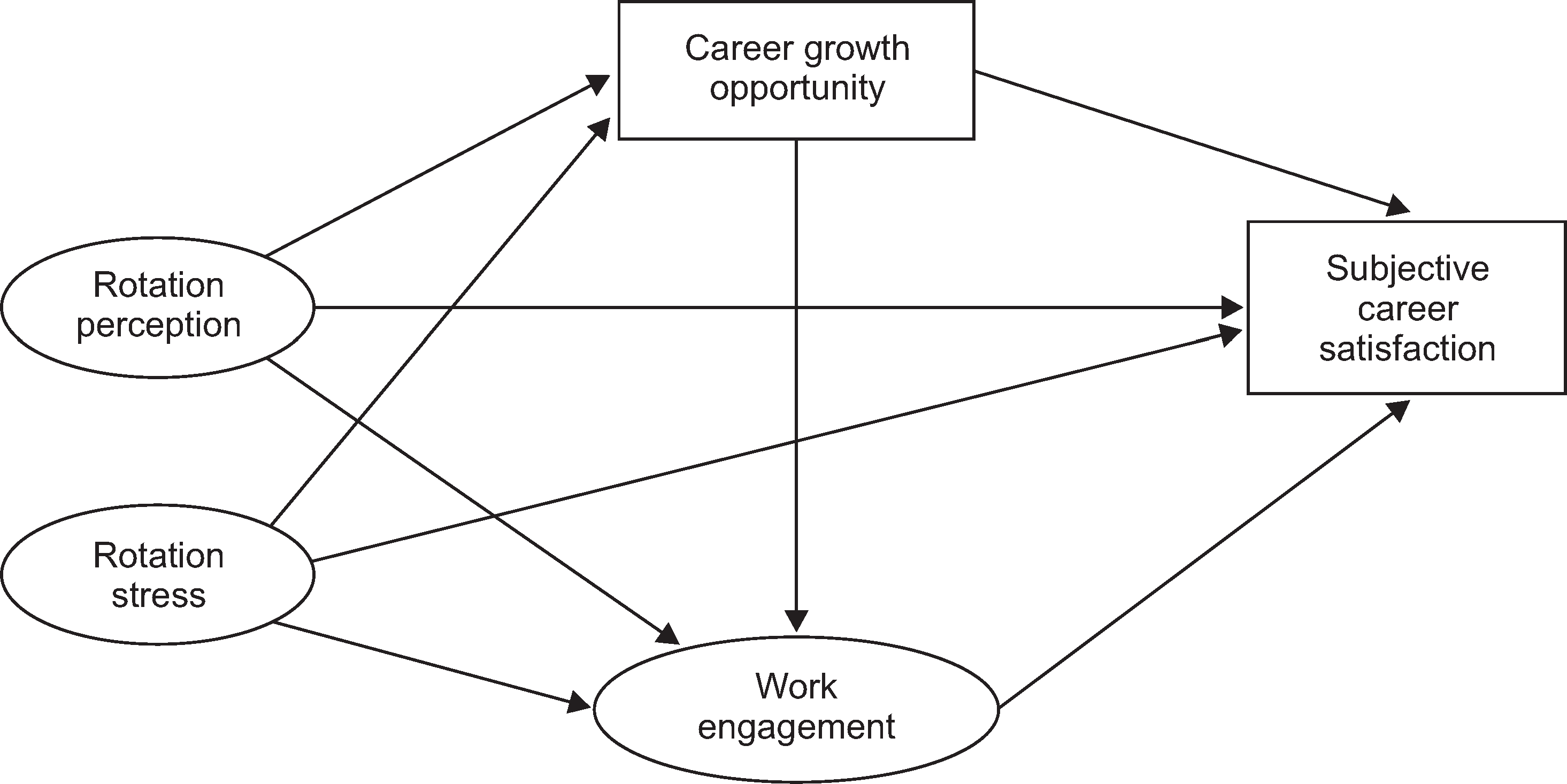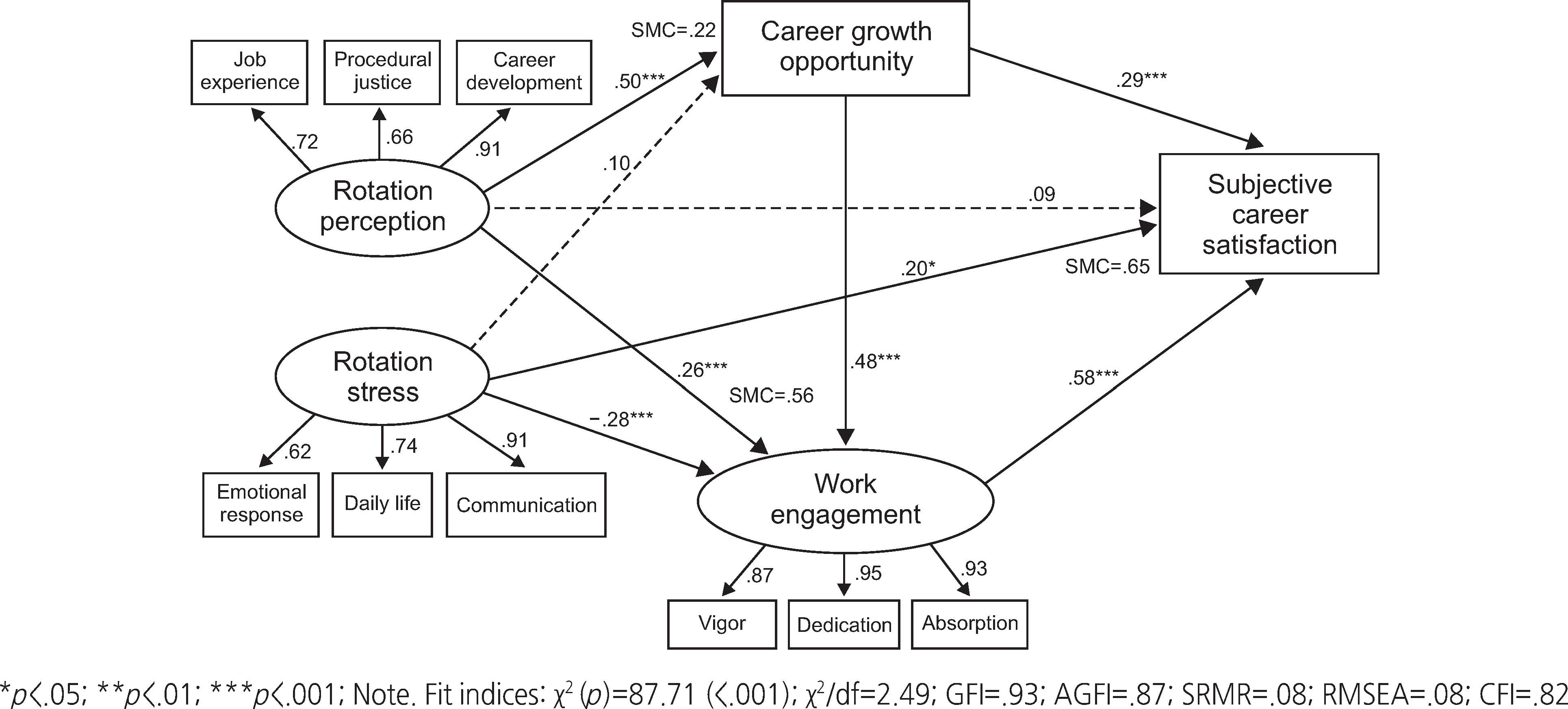Abstract
Purpose
This study aimed to present and test a structural model for describing and predicting the factors affecting subjective career satisfaction of nurses experiencing rotation and to develop human resources management strategies for promoting their career satisfaction related to rotation.
Methods
In this cross-sectional study, we recruited 233 nurses by convenience sampling who had over 1 year of career experience and who had experienced rotation at least once at G university hospital. Data were collected from August to September in 2016 using self-reported questionnaires. The exogenous variables consisted of rotation perception and rotation stress. Endogenous variables consisted of career growth opportunity, work engagement, and subjective career satisfaction. A hypothetical model was tested by asymptotically distribution-free estimates, and model goodness of fit was examined using absolute fit, incremental fit measures.
Results
The final model was approved and had suitable fit. We found that subjective career satisfaction was directly affected by rotation stress (b=.20, p=.019) and work engagement (b=.58, p<.001), indirectly affected by rotation perception (b=.43, p<.001) through career growth opportunity and work engagement. However, there was no total effect of rotation stress on subjective career satisfaction (b=-.09, p=.270). Career growth opportunity directly and indirectly affected subjective career satisfaction (b=.29, p<.001; b=.28, p<.001). These variables accounted for 65% of subjective career satisfaction.
References
1. Moon IO. The structural model about impact of nurse’s career management, career plateau, career satisfaction on career commitment. Journal of Korean Academy of Nursing Administration. 2010; 16(2):180–189. http://dx.doi.org/10.11111/jkana.2010.16.2.180.

2. Ho WH, Chang CS, Shih YL, Liang RD. Effects of job rotation and role stress among nurses on job satisfaction and organizational commitment. BMC Health Services Research. 2009; 9:8. http://dx.doi.org/10.1186/1472-6963-9-8.

3. Eriksson T, Ortega J. The adoption of job rotation: testing the theories. ILR Review. 2006; 59(4):653–666. http://dx.doi.org/10.1177/001979390605900407.

4. Park KN. Social capital of managerial women and structuration of gender related job segregation. Korean Journal of Sociology. 2002; 36(6):109–135.
5. Järvi M, Uusitalo T. Job rotation in nursing: a study of job rotation among nursing personnel from the literature and via a questionnaire. Journal of Nursing Management. 2004; 12(5):337–347. http://dx.doi.org/10.1111/j.1365-2834.2004.00445.x.
6. Huang S, Lin YH, Kao CC, Yang HY, Anne YL, Wang CH. Nursing job rotation stress scale development and psychometric evaluation. Japan Journal of Nursing Science. 2016; 13(1):114–122. http://dx.doi.org/10.1111/jjns.12095.

7. Lee SJ. The effects of general hospital nurses’stress due to inter-departmental shift and their physical responses [master’s thesis]. Seoul: Kyung Hee University;2005. p. 1–55.
8. Schaufeli WB, Salanova M. Enhancing work engagement through the management of human resources. Naswall K, Hellgren J, Sverke M, editors. The Individual in the Changing Working Life. NY: Cambridge University Press;2008. p. 380–402.

9. Zaghloul AA, Abou El Enein NY. Nurse stress at two different organizational settings in Alexandria. Journal of Multidisciplinary Healthcare. 2009; 2:45–51. http://dx.doi.org/10.2147/JMDH.S5404.

10. Kim CS. Relationship between types of mentoring, career development and career satisfaction among security agents. The Journal of the Korea Contents Association. 2010; 10(10):351–358. http://dx.doi.org/10.5392/JKCA.10.10.351.

11. Choo SW. The relationship between job stress and career satisfaction in the moderating role of type of work. Journal of Tourism and Leisure Research. 2014; 26(8):153–174.
12. Kwon JS. The effects of perceived organizational support and perceived supervisory support on career success: focusing on the person-organization fit. Journal of Organization and Management. 2010; 34(4):87–109.
13. Kwon NK, Kim HL. Examination of the effect of job rotation on subjective career satisfaction: the mediating effect of employability. The Journal of the Korea Contents Association. 2014; 14(8):431–441. http://dx.doi.org/10.5392/JKCA.2014.14.08.431.
14. Park JC. The effects on the hotel employees’ job rotation influence to customer orientation and career success based on employee value proposition. Korea Journal of Tourism and Hospitality Research. 2013; 27(5):67–86.
15. Lee JH, Jeon JH. The impact of employability on organizational commitment and turnover intention mediated by career growth opportunities. Journal of Human Resource Management Research. 2016; 23(1):47–67. http://dx.doi.org/10.14396/jhrmr.2016.23.1.47.

16. Cheon BY, Lee HS, Park SM. The impact of organizational and personal characteristics on the person-job fit, career commitment and career satisfaction. The Korean Journal of Human Resource Development. 2012; 14(2):47–78. http://dx.doi.org/10.18211/kjhrdq.2012.14.2.003.
17. Kim HJ, Hyun SH, Kim IS. Examining the relationships among hotel employees’ job demands, job resources, work engagement, self efficacy and department performance. Journal of Tourism Sciences. 2003; 37(8):33–53.
18. Lee YS, Kwon KB, Kim WC, Cho DY. Work engagement and career: proposing research agendas through a review of literature. Human Resource Development Review. 2016; 15(1):29–54. http://dx.doi.org/10.1177/1534484316628356.
19. Song TM, Kim GS. Structural equation modeling for health & welfare research. Seoul: Hannarae;2012. p. 164–165.
20. Nouri H, Parker RJ. Career growth opportunities and employee turnover intentions in public accounting firms. The British Accounting Review. 2013; 45(2):138–148. http://dx.doi.org/10.1016/j.bar.2013.03.002.

21. Schaufeli WB, Bakker AB, Salanova M. The measurement of work engagement with a short questionnaire: a cross- national study. Educational and Psychological Measurement. 2006; 66(4):701–716. http://dx.doi.org/10.1177/0013164405282471.
22. Yi R. The role of emotional labor strategies in the job demand-resource model with burnout and engagement: call center employees case [master’s thesis]. Suwon: Aju University;2006. p. 1–91.
23. Greenhaus JH, Parasuraman S, Wormley WM. Effects of race on organizational experiences, job performance evaluations, and career outcomes. Academy of Management Journal. 1990; 33(1):64–86. http://dx.doi.org/10.2307/256352.

24. Jung MH. Hotel employee’s perception of job rotation influencing subjective career success: focused on the moderating effects of job rotation and job characteristics [master’s thesis]. Seoul: Sejong University;2010. p. 1–174.
25. Kline RB. Principles and practice of structural equation modeling. 2nd ed. New York: Guilford Press;2005.
26. Chen SY, Wu WC, Chang CS, Lin CT. Job rotation and internal marketing for increased job satisfaction and organisational commitment in hospital nursing staff. Journal of Nursing Management. 2015; 23(3):297–306. http://dx.doi.org/10.1111/jonm.12126.

27. Kim YN. Effect of career development and career plateau on career satisfaction of nurses. Journal of Korean Public Health Nursing. 2016; 30(1):83–92. http://dx.doi.org/10.5932/JKPHN.2016.30.1.83.

28. Yoon SH. The effects of organizational managerial characteristics and job characteristics on job stress and job effectiveness: a survey on clinical nurses. The Korean Journal of Industrial and Organizational Psychology. 2004; 17(3):451–466.
29. Garrosa E, Moreno-Jiménez B, Rodríguez-Mu oz A, Rodrí-guez-Carvajal R. Role stress and personal resources in nursing: a cross-sectional study of burnout and engagement. International Journal of Nursing Studies. 2011; 48(4):479–489. http://dx.doi.org/10.1016/j.ijnurstu.2010.08.004.

30. Sim YH, Yoo TY. The influence of person-job fit on job engagement: focus on mediating effect of meaning and competence. The Korean Journal of Industrial and Organizational Psychology. 2009; 22(3):399–420.
Table 1.
General Characteristics (N=233)
Table 2.
Descriptive Values and Correlations among Variables (N=233)
Table 3.
Path Coefficients of the Final Model




 PDF
PDF ePub
ePub Citation
Citation Print
Print




 XML Download
XML Download